Social media analytics, sentiment analysis included, are at the heart of successfully managing your social media presence. Be it Facebook, Instagram, or Twitter, gathering and analyzing performance data prevails as the common factor in making informed social media marketing decisions.
? Read Media Monitoring: The Ultimate Guide
There’s so much data being posted on social media every day, it might be difficult to keep up. You not only want to know what’s being said about your own brand, you want to know what’s abuzz about your competitors, your industry, and emerging trends among your customers. You want an in.
Analyzing sentiment plays such a crucial part in deciphering the way your audience perceives you, your products, and your position in the marketplace.
That’s why this guide will help you recognize opportunities and ways you can use sentiment analysis to optimize your social media marketing strategy.
What is Social Media Sentiment Analysis?
Social media sentiment analysis is the process of interpreting and determining whether the social media collected text data is positive, negative, or neutral. It goes beyond just collecting and counting the number of mentions, comments, or hashtags.
Analyzing sentiment gives you deeper insight into the attitudes, opinions, and emotions behind the text. It tells you whether that collected Facebook post was mentioning you in a positive or negative light. It gives context to your number of mentions.
Say you suddenly have a spike in the number of your brand mentions. Without sentiment analysis, it’s impossible to immediately know whether that’s a good or a bad thing. One look at a sentiment analysis chart and you’ll know right away.
Analyzing sentiment gives way for an even deeper analysis of your mentions. Once you know the underlying prevailing sentiment is negative, for instance, you can dig deeper to discover the root cause of the negatively charged brand mentions.
Without the sentiment analysis, you may have been none the wiser – thinking a rising number of mentions is a good thing.
But that’s not all sentiment analysis is good for.
5 Ways to Use Social Media Sentiment Analysis Data
Analyzing social media sentiment is beneficial for many reasons, five of which we’ve covered below. From getting audience and brand insights to helping you discover and manage a social media crisis, sentiment analysis has got your back.
1. Audience insights & changing consumer trends
Figuring out what makes the audience tick is not a new practice among marketers and PR professionals alike. The practices and platforms may have evolved over time, but one thing remains constant: working to understand your audience’s thoughts, opinions, perceptions, and feelings.
The consumer mindset changes over time, as is only natural. However, as your customer changes and evolves, so must you, too. This is why learning and keeping up with the changes has become so important.
Take the coronavirus pandemic and the resurgence of the Black Lives Matter movement, for instance. Both have so significantly marked 2020. The pandemic has upturned everyone’s lives overnight it seems. Both the pandemic and the BLM movement have completely changed the way people interact and relate with, not only each other but brands, too. Social media activism was (and still is) at an all-time high. The same went for performative activism, though. Not much went under the radar during this high-alert period. Brands were not exempt from scrutiny and demand for genuine allyship.

As Debra Aho Williamson, an analyst at Insider Intelligence, said:
“At a time when nearly every aspect of life has been altered by business closures, stay-at-home orders, social distancing and job losses—and when consumers are demanding that companies do more than pay lip service to issues of race and equality—it’s more critical than ever for businesses to listen to their consumers.”
Analyzing sentiment would have been especially important during the last year, and still today. Every brand’s communication strategy on social media was put under the microscope. Tracking how people reacted to a brand’s decisions regarding the pandemic (be it pandemic prompted layoffs, measures compliance…) and the BLM support would have given them the insight they wouldn’t have had otherwise.
What exactly can you find out?
Brands can track campaigns they’ve created, hashtags they’ve started, statements they’ve given. Sentiment analysis would give them information about the success of every action they take. Do the reactions lean more towards the positive or negative? Why one or the other? What are the negative mentions mostly about and what can you do to fix it? What about the positive ones? Can you capitalize on positive mentions by sharing them, retweeting them, emphasizing them?
Research conducted by Gartner in 2020 and reported by eMarketer only further confirmed the importance of social listening in 2020. When asked “From which sources are you getting rapid information about consumers during the coronavirus pandemic?”, 51% of respondents answered with social listening platforms – taking second place after third-party sources of consumer research.
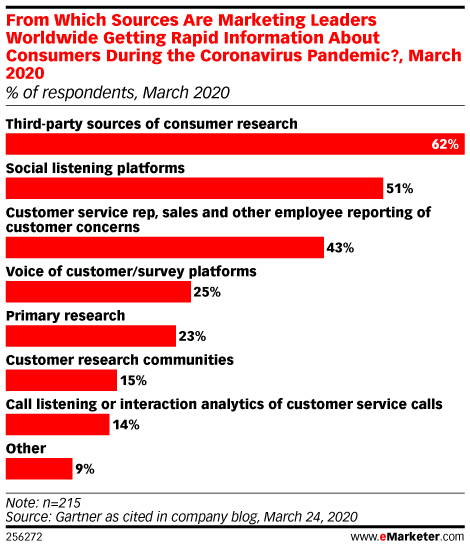
And truly, nowadays there is no such platform that can offer you real-time, unbiased information like social media monitoring tools can. The Kahlúa liqueur brand certainly agrees:
“We’ve used social listening in the past two months to report all the way to top management, to our CEO. We are showcasing that we can provide meaningful insights faster than traditional insight campaigns or surveys would do.”
Simon de Beauregard (Engagement Director for Absolut, Malibu, Kahlúa, and Smithworks labels) for eMarketer in July 2020
And not only did they use social listening for reporting results, but they’ve also used it for social media engagement and finding leads:
Consistently tracking and analyzing the sentiment of your mentions (brand mentions, related keywords, and industry topics, including your competitors) means you’re staying proactive in recognizing positive/negative rising trends, discovering potential opportunities or issues, recognizing changes in consumer sentiment towards your brand and much more.
2. Getting brand insights
While somewhat similar to getting audience insights, brand insights are more narrowly focused. You still want to know how and what your audience thinks, but now it’s more closely related to your brand. Your best starting point is tracking your own brand name, related products/services, and important people (be it your CEO, PR or marketing manager, or influencers/brand ambassadors you work with).
This way you can start building up a base of mentions you can analyze from the start and track the changes over time. You can compare time periods and see how your brand image fluctuates between those time periods. If it fluctuates at all.
Sentiment analysis is the best metric for this purpose. You may accumulate a lot of brand mentions in one time period or see a sudden rise in the number of mentions. However, without looking at the sentiment of those mentions, you can’t know if that’s a positive or a negative thing for your brand.
That’s why sentiment analysis is an important jumping-off point for a much deeper analysis of your brand positioning.
Read How to Improve Brand Awareness with Determ
Analyze brand reputation over time
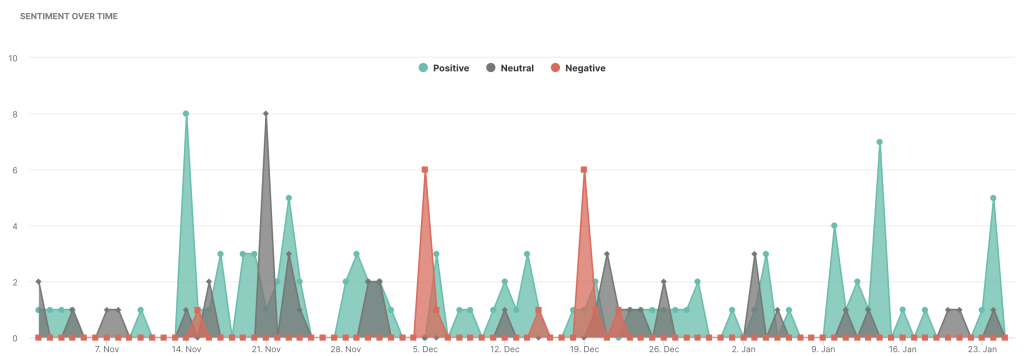
Tracking how your brand sentiment changes over time gives you an insight into how your audience feels about you over different periods of time. You can see a rise and fall in negative mentions and compare it to your communication strategy. Maybe that one campaign got you a lot of negative social media attention. Or an unsavory story from your CEO’s past came up and you failed to deliver a timely response. Maybe that one tweet for Women’s Day brought an avalanche of criticism your way (looking at you, Burger King). The examples are infinite.
The point, though, is that you can always track how your actions affect your brand reputation and positioning. From one small tweet to a whole new campaign, each move you make (or don’t make) on social media leaves a lasting impression on your audience. One you can track and analyze.
Read Brand Reputation Management: Top 5 Tips for Success
Compare your brand image to that of your competitors
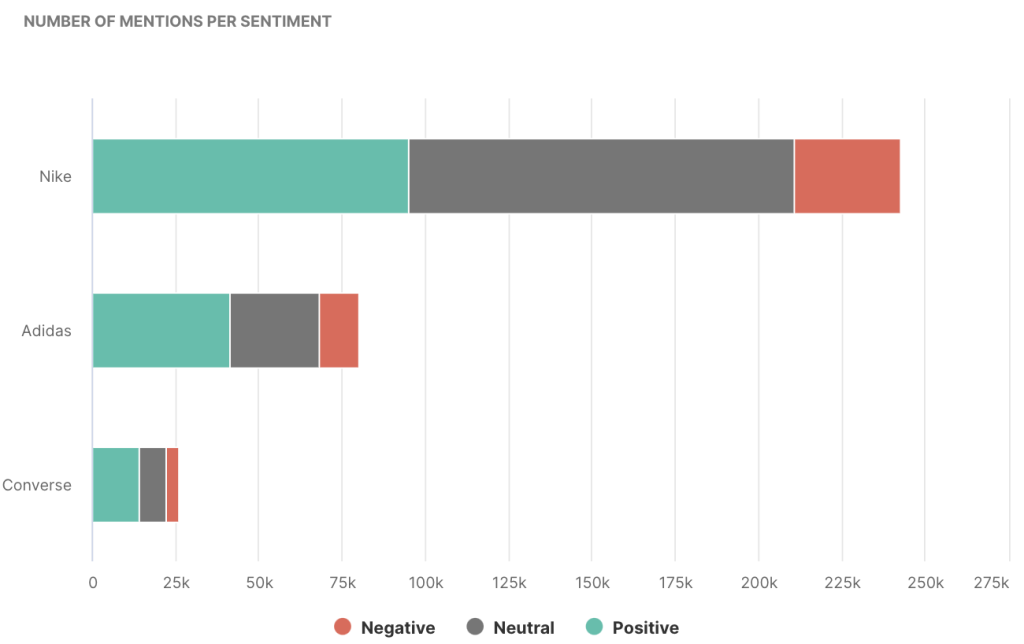
Not only can you benchmark the number of your brand mentions against those of your competitors, but you can also see if the prevailing sentiment is positive or negative. If you notice your competitor has a greater number of positive mentions than you, you can look into it. See how their social media strategy compares to yours and what you can do to improve your own.
Track your brand’s performance on different social media platforms
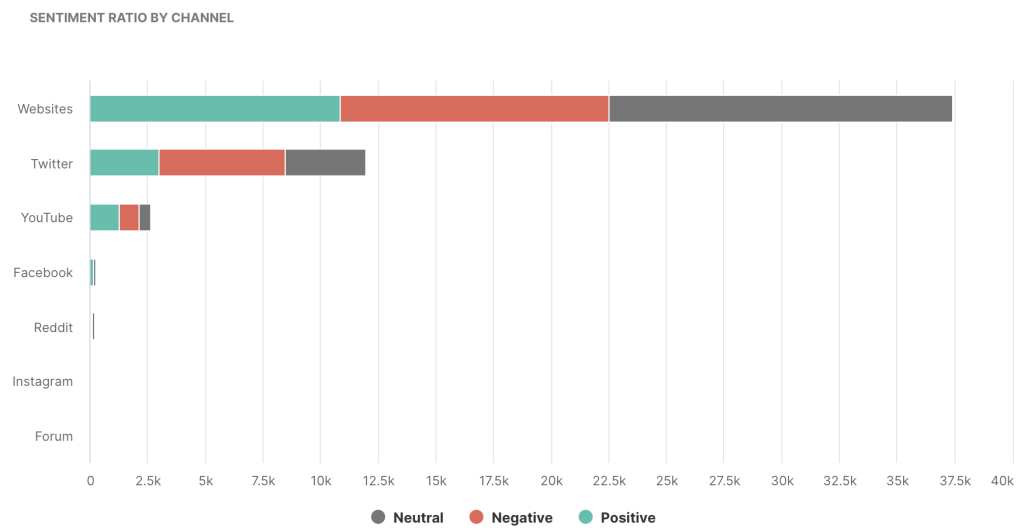
You can compare the number of brand mentions and analyze their sentiment over different channels. This way, you can see where your brand performs best and worst. Using this information, you can see what and where you can improve to engage your audience more. Or, you may even come to the conclusion that a certain social media channel simply doesn’t work for your brand. Either way, you’ll know and be able to make informed decisions.
Automate the process of setting sentiment
If you’ve been in the game for a while, you must already know some weak points of your business – things your customers have been complaining about and pointing out to you. Either directly via emails or by publicly tagging you on social media. Likewise, you also know what works for your brand and brings you positive attention.
If you’re a relatively new business, still dipping your toes in and trying to get a feel for your product, you may need some help figuring it out. Or, even if you are an aforementioned established brand and just want to find out more about how your customers talk about you online – media monitoring is a great tool to use in both situations.
What’s more, with tools like Determ, you can now automate the process of setting sentiment for certain keywords, authors, or websites.
Let’s say you’re an airline that’s been tracking your social media brand mentions for a while. Specifically, you’ve grouped your brand mentions into four highly specific tags for a more focused tracking: In-Flight Service, Customer Service, Delays & Cancellations, Tickets & Reservations. This means that all your brand mentions that are about flight delays go into the Delays & Cancellations tag. Or mentions about your in-flight food quality go into the In-Flight Service tag.
Now, you’ve noticed there’s a rising negative sentiment in your In-Flight Service tag. Upon further inspection, you find out that there’s a rising number of passengers complaining about your in-flight service, more specifically the flight crew and their unprofessional attitudes towards the passengers. To keep an eye on the situation and make sure none of these mentions escape the negative sentiment, you can automate tagging sentiment.
How Determ’s Automated Actions work
Here’s how it works. Type in the keywords commonly used in those mentions complaining about the flight crew. For instance:
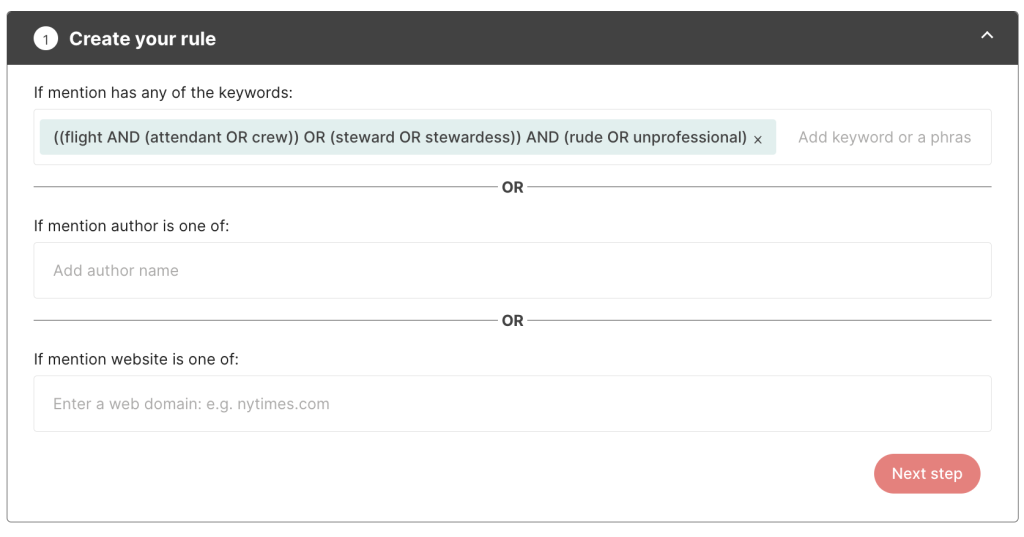
Then, set the sentiment as negative and choose the tag you want those mentions to go into:
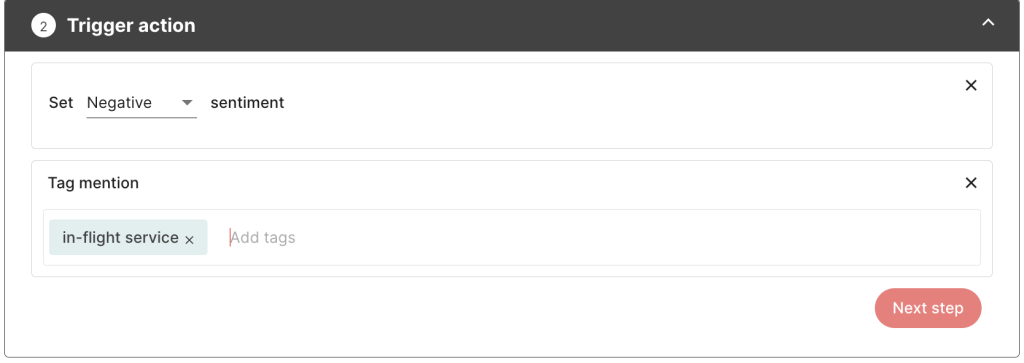
Now, every time your flight crew is mentioned alongside words such as rude or unprofessional, they’ll be immediately assigned a negative sentiment and grouped into the In-Flight Service tag.
Indeed, these are the mentions that might have still been assigned negative sentiment (without you having to use Automated Actions). However, it’s not always this cut and dry. There might have been more ambivalent words, sarcasm or irony used that a tool can’t recognize by itself. So, instead of you having to manually correct the sentiment of those mentions, you “tell” the tool what keywords to keep an eye on.
3. Improving customer support & experience
Great customer support is a natural consequence of analyzing and acting on consumer and brand insights you’ve collected. Once you understand your customers better, their behavior, needs, and problems, you can offer them a better brand experience.
Media monitoring proves to be a great ally when it comes to maintaining a high level of engagement with your audience over social media. By now we’ve talked enough about the importance of not only counting the number of mentions but analyzing their sentiment.
In the case of customer support, it’s even more important. Take negative mentions, for instance. Just by going through all your negative mentions, you can discover potential issues with your product or service. Maybe it malfunctions, maybe your customers think it’s overpriced or that your staff is unprofessional. Whatever it is, is there in your negative mentions.
Let’s take it a step further. We’ve mentioned earlier an airline company as an example for using tags for their mentions. We had them separate their mentions into distinct categories for easier organization. However, you can also use tags for your customer support needs.
Read How to Conduct Sentiment Analysis to Improve Customer Experience?
Creating tags
Let’s say you’ve noticed some often complained about things concerning your product. We’re going to keep using the airline company here. We already know their passengers complained about their unprofessional in-flight crew. But, that’s not all. By tracking their brand mentions, they’ve noticed a rising number of negative mentions about frequent flight delays and dirty airplane bathrooms.
So, we’ll create these 3 new tags: Rude Crew, Delays, Dirty Bathrooms. Using automated actions you can set up a rule that every time your brand mentions contain a keyword “dirty bathroom” (and common related keywords) they get tagged negative and sent into the “Dirty Bathroom” tag.
This way, you can easily track the progression of these problems. How they change over time, does the number of negative mentions decline? What’s more, by tracking these, you can react immediately they appear and address them directly on social media. Either by answering someone’s comment, tweet, or issuing a statement.
It doesn’t have to be all about negative mentions, though. Your customers may just have questions, inquiries they need quick answers to. And what better person to answer them than you?
In keeping with the bathroom theme, here’s a fun little exchange that happened between a customer (in need of a super quick answer) and Tesco on Twitter:
Not only did Tesco reply to this man’s cry for help, but they’ve also arranged a rescue mission:
And they’ve even offered the customer a voucher for toilet paper:
Now, that’s some top-notch customer service, wouldn’t you agree?
Just the little act of acknowledging your customers online, answering their questions, and addressing their concerns goes a long way to maintaining a quality customer service experience. And, at the end of the day, building a good brand reputation.
4. Detecting a social media crisis
Analyzing sentiment is also a great tool for recognizing and mitigating potential social media crises. And it’s quite simple, too. If you’ve been tracking your brand as religiously and as detailed as mentioned thus far, there’s really little you can miss when it comes to your social media presence. Crises included.
We’ve talked a lot about tracking mentions over time and keeping an eye on the positive-negative sentiment ratio. Sudden increases in the number of mentions mean one thing – a viral response. Something you did, be it a new campaign, an Instagram post, a tweet, triggered an avalanche of reactions.
Looking only at the number of mentions, you can’t possibly know whether that viral response is a good or bad thing. Looking at the sentiment, though, you can.
If you see a sudden rise in the number of negative mentions, that’s a pretty good indicator something’s not right. In fact, you may have a budding social media crisis on hand.
Read The Importance of Instagram Customer Care
Burger King example
Burger King’s “women belong in the kitchen” tweet for International Women’s Day. They hit send tweet and this happened:

This is sentiment by the number of mentions and over time (time period is March 1-23). You can see the very obvious jump in the number of mentions on March 8 when the tweet was posted. What’s more, you can see the distribution between positive and negative mentions.
It’s worth noting that the “women belong in the kitchen” tweet was only part of a thread. The very beginning, in fact. Some saw the whole thread, some didn’t. Their intention was good, as they wanted to promote the new culinary scholarship program for their female employees. And they wanted to point out the gender disparities in the restaurant industry.
Some didn’t find the issue with the tweet, some did. These mentions include a lot of tweets calling out Burger King, mocking memes, but also many news outlets reporting and analyzing the situation.
Whatever the case, Burger King was in a hot seat. In the beginning, they didn’t apologize, trying to explain and justify the meaning behind their tweet. However, as you can see, the negative comments persisted for a few days, so Burger King finally acquiesced and apologized.
The point here is, this is why media monitoring is so great. It’s real-time, meaning you know something’s wrong the second it starts happening. And you can analyze the hows, whys, and whats. Also meaning you can (you should) react quickly and efficiently.
A timely, well-thought-out response is crucial at a time like this. Ignoring the situation is the absolute worst thing you can do. The best thing you can do we’ve covered in this Social Media Crisis Management Guide.
5. Tracking a social media campaign performance
By now, you know the drill. You analyze sentiment to give context to your mentions. This is no less important for analyzing a campaign performance than it is for any other part of your marketing strategy. Especially when it is all so connected.
Take the Burger King example. Their intention was to promote their new culinary scholarship program for female employees while addressing the existing gender gap among chefs in the industry. The campaign was set to be released for International Women’s Day. While their intention may have been good, their delivery… not so much. The “women belong in the kitchen” approach they took to promote the campaign on Twitter was not received well. Hence, the rising number of negative brand mentions we’ve shown in the chart above.
This scenario is a perfect example of being able to quickly detect a developing social media crisis by closely tracking the campaign’s online presence and reactions.
Media monitoring tools offer an overview of your campaign’s online performance:
- Campaign’s reach via the number of mentions and impressions
- Most popular social media channels (e.g. by looking at the Number of mentions per channel chart)
- The influencers/brand ambassadors with the highest reach and engagement
- Campaign success via sentiment analysis
Read Campaign Tracking: How to Monitor your Marketing Efforts with Determ?
Campaign success via sentiment analysis
Here are a few ways you can analyze the success and performance of your campaign using sentiment:
Interpreting overall sentiment ratio
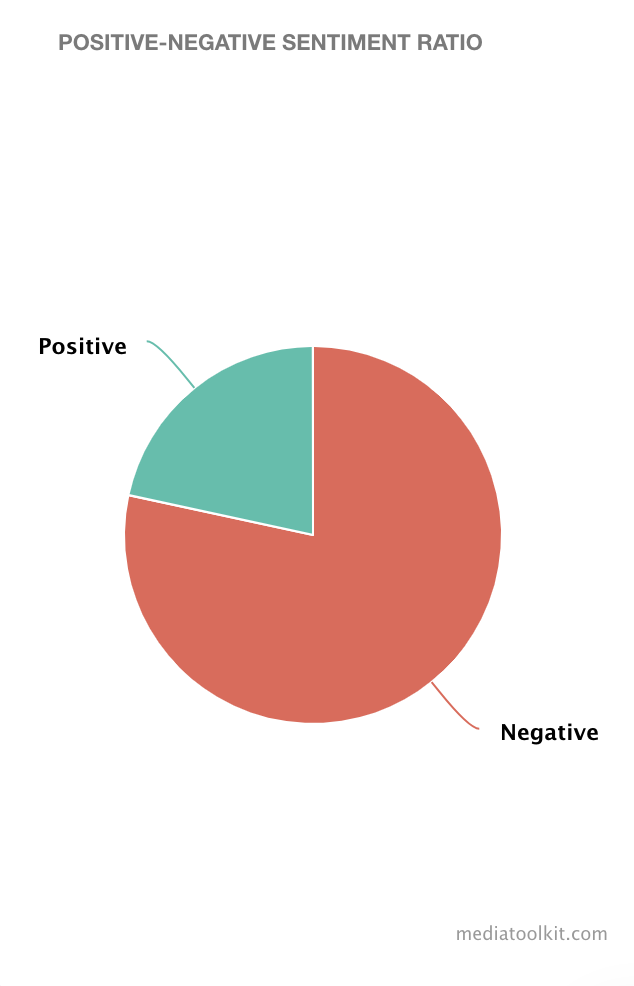
The sentiment ratio gives you an insight into the prevailing reactions and emotions towards your campaign. That is, it tells you whether the campaign response was positive or negative. What’s more, you can dive deeper into the analysis by checking out the positive and negative mentions. This step is important because it gives context to your mention sentiment. The why behind the positive or negative mentions.
Analyzing sentiment ratio by channel
Sentiment ratio by channel gives you an insight into how well your campaign performed across different social media platforms. It analyzes sentiment for each platform, so you can know which platform performed best and which didn’t fare so well. This information can help you in the decision-making process for your next campaign. Which channels surprised you and showed promise? Maybe you discovered a new channel you can utilize better next time. Which channels should you use less or not at all?

Discovering top influencers by sentiment
If you’re using influencers or brand ambassadors in your campaign, you can compare their performance results. Whose post reached the most people and on which platform? Were their reach and engagement positive or negative?
For instance, streetwear brand Suspicious Antwerp is known for using famous names in their social media strategy. Gigi Hadid, Barbara Palvin, Dylan Sprouse, Tom Holland, Camila Mendes, Brooklyn Beckham, Ed Westwick are just some of the celebrities they’ve collaborated with. They often collaborate with celebrities when announcing and promoting their new collections.
To keep up with how each name attached to the promotion affected their campaign, they can simply use media monitoring. We’ve talked about tags a couple of times by now. Well, we’re going to mention them once again because they’re a great feature for organizing your mentions.
This time, we’re organizing mentions for Suspicious Antwerp’s Peacekeeper collection partners: Drew Ray Tanner, Myles Jones, and Casimere Jollette. To make sure, for instance, that every mention of Myles Jones within the context of Suspicious Antwerp goes into the Myles Jones tag, you can use Automated Actions:
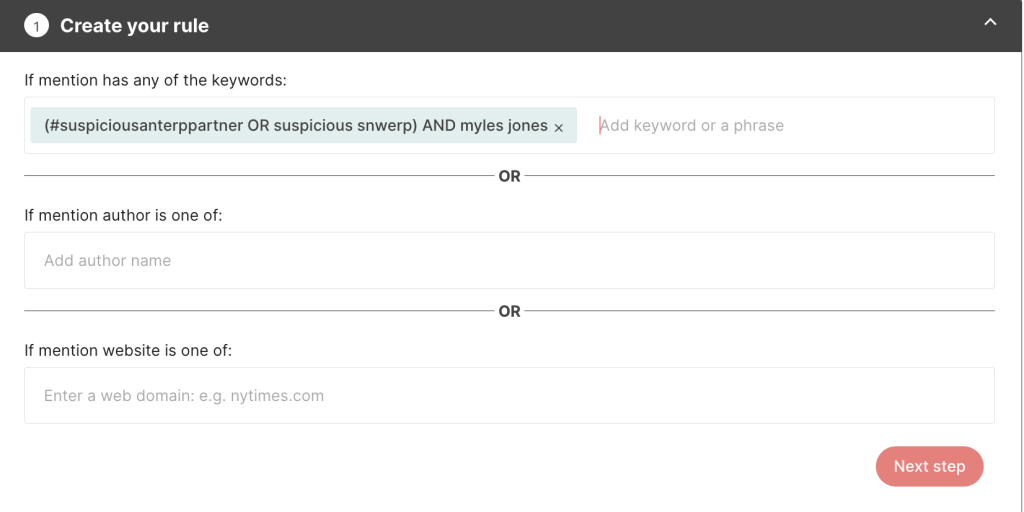

This way, you don’t have to do it manually. Instead, the tool does it for you.
All this allows you to very clearly track how each brand partner performs on social media. Use the knowledge we’ve already shared and track their overall sentiment ratio, the sentiment ratio by channel, their reach…
Sentiment Analysis Report Example: Burger King Women’s Day Tweet
We’ve talked about Burger King above and already showed you one example of a sentiment analysis chart. So you can get a better understanding of how a sentiment analysis report works in practice, we’ve created a fully custom sentiment analysis report with different charts using Determ. These are only some of the custom charts you can use in your analysis and can add or edit them as you see fit.
Here’s a quick preview of the chart:

How to do a Facebook Sentiment Analysis?
Creating a Facebook sentiment analysis is pretty straightforward when it comes to media monitoring tools, and not much different than the report we’ve shown above. In essence, a Facebook sentiment analysis means analyzing sentiment exclusively from Facebook text data. There are two ways you can do this using a media monitoring tool like Determ.
First, when you go to create a query (e.g. Burger King Women’s Day Tweet), you can select Facebook as the sole source of your mentions. This means your media monitoring feed will be filled only with Facebook mentions. Whereas, it’s usually filled with different source types if you don’t use filters.
If you didn’t filter the sources when creating a query, either because you forgot or just didn’t think you’ll need to, reporting is going to be a little more complicated. Again, there are two ways you can deal with this:
- You can create the query again, but now only choosing Facebook as the source. This is possible because the system collects historical data from the tool archive and live information from the internet and displays it in the feed.
- Or you can get Facebook insights from your original query using custom charts and the trimming feature. Just add trimming condition “Allowed” to your Source Type (sub)dimension and type in “Facebook”. The tool will recognize this as having to only display Facebook data. It can be a little tricky and you won’t be able to create all the charts you would have been able to create otherwise. However, you can use this option if no other is available.
Either way, you can create a fully customizable Facebook sentiment analysis report, just like you would a sentiment analysis report including all sources.
In Conclusion
We’ve covered a lot of ground in this guide, but if there’s one main takeaway it’s this: sentiment analysis provides context.
It provides context to your mentions, their number, their reach, and their influence. Without analyzing sentiment, you haven’t really analyzed anything. Numbers are great, but what use can they be if you don’t know the story behind the numbers?
Continually tracking your brand mentions and analyzing sentiment long-term means a better social media performance and a thriving brand image.



